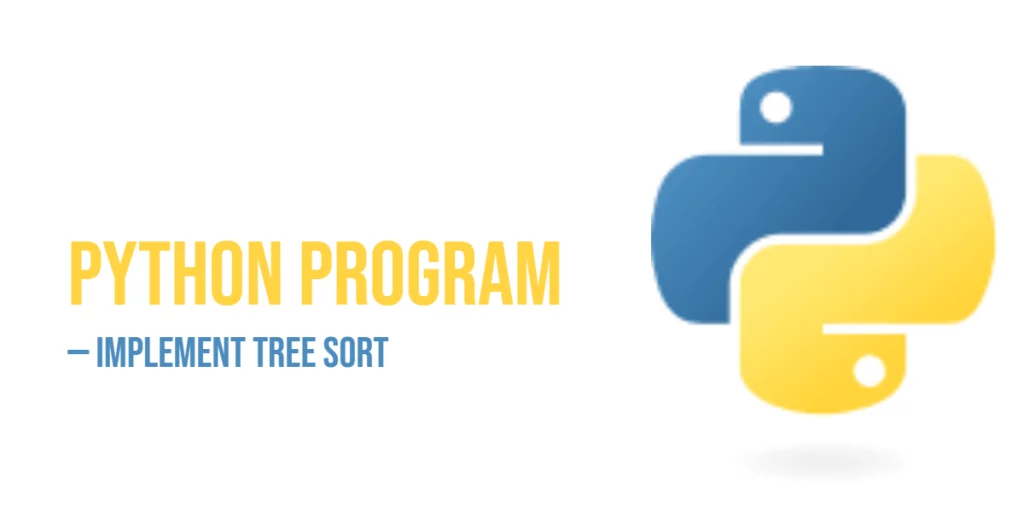Sorting is a fundamental concept in programming, helping developers organize data for easy access and analysis. One of the most interesting and efficient sorting methods is Tree Sort, which uses a Binary Search Tree (BST) to sort elements. Unlike simple sorting algorithms like Bubble Sort or Insertion Sort, Tree Sort leverages the hierarchical structure of a BST to arrange data efficiently. Learning Tree Sort also introduces beginners to important concepts in data structures, such as binary trees, recursion, and in-order traversal.

with hands-on learning.
get the skills and confidence to land your next move.
Python is a beginner-friendly programming language, widely known for its readability and simplicity. Implementing Tree Sort in Python provides a hands-on way to understand both algorithms and data structures. It allows learners to see how tree structures naturally organize data while also giving practice with recursion and object-oriented concepts. In this article, we’ll explore multiple approaches to implementing Tree Sort in Python, covering recursive insertion, iterative methods, handling duplicates, and class-based designs, making it accessible for beginners.
Program 1: Basic Tree Sort Using Recursive BST Insertion
This first program demonstrates the standard Tree Sort using recursive insertion into a Binary Search Tree. An in-order traversal retrieves the sorted list.
class Node:
def __init__(self, data):
self.data = data
self.left = None
self.right = None
def insert(root, data):
if root is None:
return Node(data)
if data < root.data:
root.left = insert(root.left, data)
else:
root.right = insert(root.right, data)
return root
def inorder(root, result):
if root:
inorder(root.left, result)
result.append(root.data)
inorder(root.right, result)
def tree_sort(arr):
root = None
for num in arr:
root = insert(root, num)
sorted_list = []
inorder(root, sorted_list)
return sorted_list
numbers = [5, 2, 9, 1, 5, 6]
print("Original List:", numbers)
sorted_numbers = tree_sort(numbers)
print("Sorted List:", sorted_numbers)In this example, each number is inserted into the BST according to its value. Smaller numbers go to the left, and larger numbers go to the right. Performing an in-order traversal retrieves the elements in ascending order. Beginners can easily visualize how the tree structure naturally organizes data and simplifies sorting.
Program 2: Tree Sort Using Iterative Insertion
Instead of recursion, Tree Sort can also be implemented using an iterative approach for insertion. This method is useful for larger datasets where recursion might lead to stack overflow.
class Node:
def __init__(self, data):
self.data = data
self.left = None
self.right = None
def insert_iterative(root, data):
new_node = Node(data)
if root is None:
return new_node
current = root
while True:
if data < current.data:
if current.left is None:
current.left = new_node
break
current = current.left
else:
if current.right is None:
current.right = new_node
break
current = current.right
return root
def inorder(root, result):
if root:
inorder(root.left, result)
result.append(root.data)
inorder(root.right, result)
def tree_sort(arr):
root = None
for num in arr:
root = insert_iterative(root, num)
sorted_list = []
inorder(root, sorted_list)
return sorted_list
numbers = [7, 3, 8, 4, 2, 6]
print("Original List:", numbers)
sorted_numbers = tree_sort(numbers)
print("Sorted List:", sorted_numbers)Iterative insertion demonstrates an alternative way to build a BST without recursion. Beginners can understand how tree navigation and element placement work step by step, making it suitable for handling large datasets.
Program 3: Tree Sort Using Recursive Traversal Only
Sometimes the tree is prebuilt, and sorting is achieved solely through traversal. This example focuses on extracting sorted elements from an existing BST.
class Node:
def __init__(self, data):
self.data = data
self.left = None
self.right = None
def inorder_traversal(root, result):
if root:
inorder_traversal(root.left, result)
result.append(root.data)
inorder_traversal(root.right, result)
# Prebuilt BST
root = Node(5)
root.left = Node(2)
root.right = Node(9)
root.left.left = Node(1)
root.left.right = Node(4)
sorted_list = []
inorder_traversal(root, sorted_list)
print("Sorted List from Prebuilt Tree:", sorted_list)In this program, the BST is already created, and in-order traversal retrieves elements in ascending order. Beginners can see how traversal alone can sort data without focusing on insertion logic.
Program 4: Tree Sort With Duplicate Handling
Tree Sort can handle duplicate elements by keeping a count of repeated values within each node. This ensures that duplicates are sorted correctly.
class Node:
def __init__(self, data):
self.data = data
self.count = 1
self.left = None
self.right = None
def insert(root, data):
if root is None:
return Node(data)
if data == root.data:
root.count += 1
elif data < root.data:
root.left = insert(root.left, data)
else:
root.right = insert(root.right, data)
return root
def inorder(root, result):
if root:
inorder(root.left, result)
result.extend([root.data] * root.count)
inorder(root.right, result)
def tree_sort(arr):
root = None
for num in arr:
root = insert(root, num)
sorted_list = []
inorder(root, sorted_list)
return sorted_list
numbers = [5, 2, 5, 1, 9, 2]
print("Original List:", numbers)
sorted_numbers = tree_sort(numbers)
print("Sorted List:", sorted_numbers)By adding a count property to each node, duplicates are efficiently handled. Beginners can see how BSTs can store additional data while still maintaining sorted order.
Program 5: Tree Sort Using a Class-Based Approach
This version wraps the BST logic and Tree Sort functionality into a single class, showcasing object-oriented programming principles in Python.
class BST:
class Node:
def __init__(self, data):
self.data = data
self.left = None
self.right = None
def __init__(self):
self.root = None
def insert(self, data):
self.root = self._insert(self.root, data)
def _insert(self, node, data):
if node is None:
return self.Node(data)
if data < node.data:
node.left = self._insert(node.left, data)
else:
node.right = self._insert(node.right, data)
return node
def inorder_traversal(self, node, result):
if node:
self.inorder_traversal(node.left, result)
result.append(node.data)
self.inorder_traversal(node.right, result)
def tree_sort(self, arr):
for num in arr:
self.insert(num)
sorted_list = []
self.inorder_traversal(self.root, sorted_list)
return sorted_list
numbers = [7, 3, 5, 2, 9, 1]
print("Original List:", numbers)
bst = BST()
sorted_numbers = bst.tree_sort(numbers)
print("Sorted List:", sorted_numbers)This class-based approach demonstrates modularity and clean structure. Beginners learn how to encapsulate both data and behavior, making Tree Sort more organized and easier to extend for more complex tasks.
Frequently Asked Questions (FAQ)
Tree Sort often raises questions for beginners. Here are some answers to clarify common doubts.
Q1: What is Tree Sort and why is it useful?
Tree Sort uses a Binary Search Tree to organize elements and retrieve them in sorted order. It’s useful because it efficiently sorts data while leveraging tree structure.
Q2: Can Tree Sort handle duplicate elements?
Yes. By maintaining a count for each node or handling duplicates during insertion, repeated elements can be sorted correctly.
Q3: How does Tree Sort compare to Quick Sort or Merge Sort?
Tree Sort has an average time complexity of O(n log n), similar to Quick Sort or Merge Sort, but an unbalanced tree can degrade performance to O(n²).
Q4: Can Tree Sort be implemented without recursion?
Yes. Iterative insertion and traversal allow Tree Sort to avoid recursion, which is useful for very large datasets.
Q5: Where is Tree Sort commonly used?
Tree Sort is useful when data naturally fits a tree structure, when duplicates need careful handling, or when sorting while building a searchable tree.
Conclusion
Tree Sort is a versatile and efficient algorithm that combines sorting with the power of Binary Search Trees. In Python, it can be implemented using recursion, iterative insertion, duplicate handling, and object-oriented programming. Each approach helps beginners understand how trees can organize data and simplify sorting.
By practicing these programs, beginners can improve their Python programming skills, gain confidence with recursion and classes, and see firsthand how data structures influence algorithm efficiency. Tree Sort is more than just a sorting algorithm—it’s a gateway to understanding structured data and intelligent data organization.







